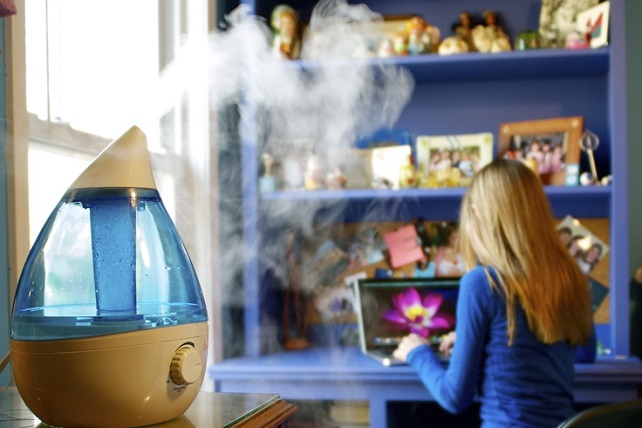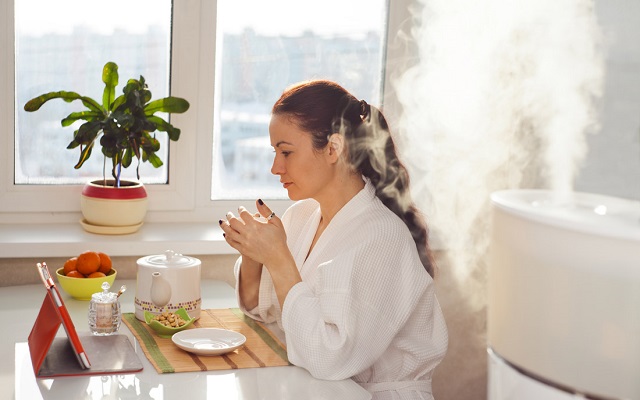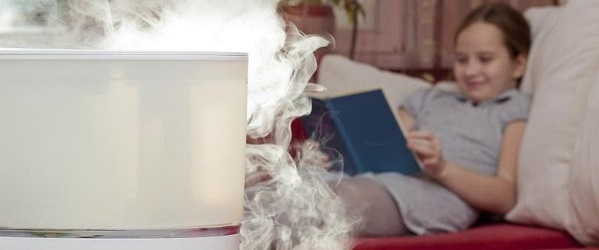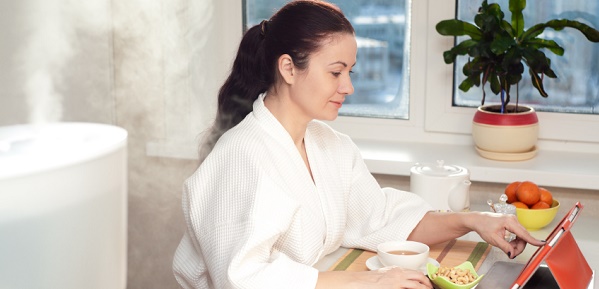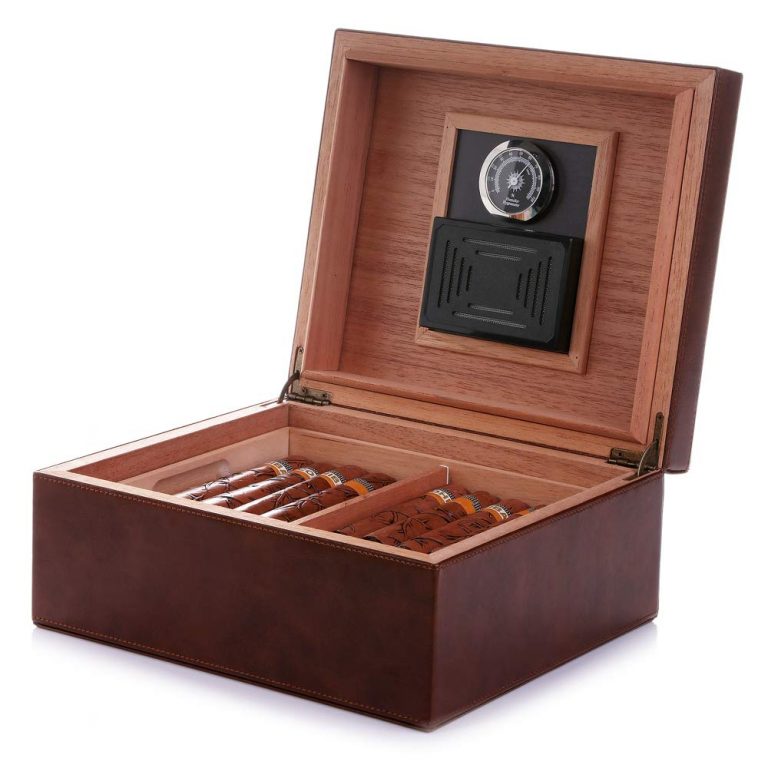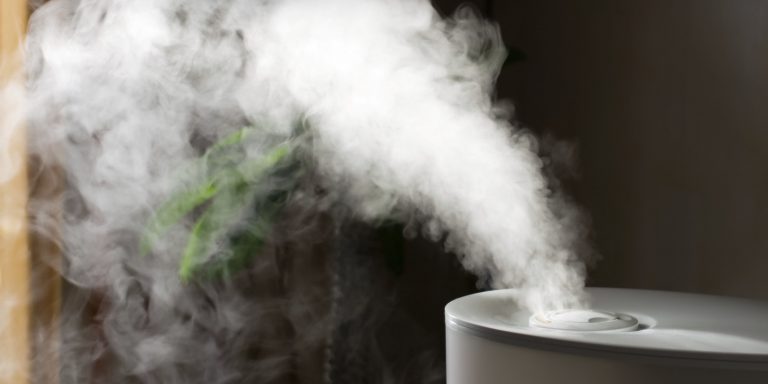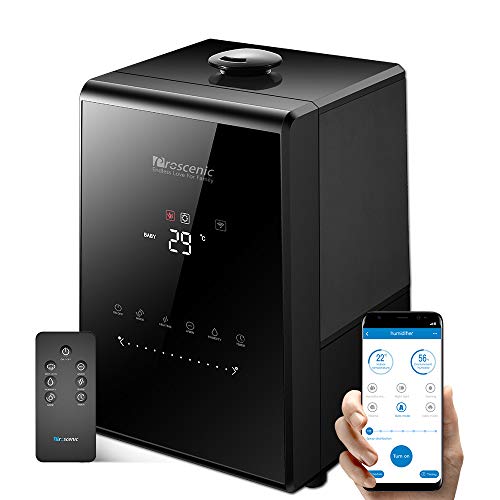Best Humidifier for Winter: Size, Features & Control
As winter rolls in and the air gets drier, I’ve found myself on the hunt for the best humidifier to combat the chill-induced dryness. It’s not just about comfort; maintaining the right humidity levels is key to keeping your skin hydrated and your respiratory system happy.
I’ve sifted through countless options, from ultrasonic to evaporative humidifiers, to bring you the lowdown on which ones truly deliver when the cold weather bites. Whether you’re looking for something for a small space or a unit that’ll handle your entire home, I’ve got you covered.
Types of Humidifiers
When considering the best humidifier for winter, it’s essential to know about the types available. Through my research and personal experience, I’ve found that the primary ones are ultrasonic and evaporative humidifiers.
Ultrasonic humidifiers use a metal diaphragm vibrating at an ultrasonic frequency to create water droplets that are then expelled to add moisture to the room. One of the main benefits of ultrasonic versions is that they’re typically quieter than other humidifiers, making them ideal for use in bedrooms or study areas.
On the other hand, evaporative humidifiers work by pushing air through a wet wick filter. As the air moves through the filter, it evaporates water from the wick and sends this moisture into the air. These devices are particularly effective because they self-regulate; the drier the air, the higher the evaporation rate.
Both ultrasonic and evaporative humidifiers have their pros and cons:
- Ultrasonic Humidifiers:
- Quieter operation
- Often feature modern designs
- Minimal maintenance required
- Evaporative Humidifiers:
- Self-regulating moisture output
- More beneficial in larger spaces
- Can filter out mineral deposits and impurities
When choosing between the two for winter use, it’s crucial to consider the size of the space you’re looking to humidify and your preference for noise level and maintenance. Ultrasonic models are great for small to medium spaces whereas evaporative humidifiers are better suited for larger areas due to their self-regulating capability.
My experience with both types has led me to prefer ultrasonic humidifiers for their quiet operation. However, for those with larger homes, an evaporative humidifier might be the more pragmatic choice due to its efficiency in widespread moisture distribution.
Ultrasonic Humidifiers
When the winter chill sets in, maintaining the moisture level in your home is a must, and ultrasonic humidifiers are my go-to solution. Ultrasonic Humidifiers work by using high-frequency vibrations to generate a fine mist that’s then released into the air. What I love most about these devices is their whisper-quiet operation, making them ideal for use in bedrooms or any space where noise is a concern.
One of the biggest advantages of ultrasonic humidifiers is that they come in various sizes, which makes them perfect for small to medium-sized spaces. Their compact design also means they’re easy to move around, so you can enjoy the benefits wherever you are in your home. I’ve found that most ultrasonic models are very user-friendly, with simple maintenance requirements — typically, a quick wipe down and a rinse out is all it takes.
However, it’s worth noting that ultrasonic humidifiers do have their drawbacks. They tend to leave behind a white dust if you’re using hard water. To combat this, using distilled water is a must. Hard water can significantly impact the humidifier’s performance and the cleanliness of your home environment.
When shopping for an ultrasonic humidifier, I always recommend looking for a model with a built-in hygrometer. This will help you maintain the optimal humidity level without having to guess or constantly monitor. Generally, the ideal indoor humidity level during winter should be between 30% and 50%.
To summarize the pros and cons of ultrasonic humidifiers:
- Pros:
- Quiet operation
- Suitable for small to medium spaces
- Easy to move and maintain
- Cons:
- Can produce white dust with hard water
- Requires distilled water for optimal performance
Investing in a good ultrasonic humidifier has made my winters much more comfortable. If you’re considering one for your home, weigh the pros and cons and think about the qualities that are most important for your comfort and health.
Evaporative Humidifiers
When considering the right humidifier for winter, it’s crucial to explore evaporative humidifiers as an option. Evaporative models work through a wick filter that absorbs water from the tank; as air passes through the filter, it evaporates the water into the air, increasing the humidity. Unlike ultrasonic models, evaporative humidifiers inherently regulate humidity because they can only emit moisture into the air at a rate that the air can hold.
One of the key advantages of evaporative humidifiers is their self-regulating ability. Since the humidification process depends on the air’s capacity to hold moisture, these devices are less likely to over-humidify a space, reducing the risk of condensation and mold growth. This is particularly beneficial during the colder months when homes are sealed up tight to preserve warmth and the air can’t hold as much moisture.
Evaporative humidifiers are also known for their ease of use. Typically, these systems don’t require as frequent maintenance as some other types, although the wick filters do need regular replacement to prevent mold and bacteria growth. Moreover, most models are virtually silent, with just a soft fan sound to ensure a good night’s sleep.
There are other practical considerations to weigh in as well:
- Water quality: Evaporative humidifiers are less prone to create white dust since any minerals are trapped in the wick filter.
- Energy efficiency: They use less electricity compared to the ultrasonic type, which is a bonus for energy-conscious consumers.
- Cost: Generally, they come with a lower initial investment but do consider the cost of replacing the wick filters.
Remember that the size and model of the evaporative humidifier you pick should match the room size to operate efficiently. Larger models are ideal for entire homes or large open spaces, while compact units work well in personal or smaller rooms. Always check for a built-in humidistat feature, as it offers the convenience of automatic humidity control, making it easier to maintain the ideal indoor humidity during winter.
Warm Mist Humidifiers
When the winter air bites with its chilly embrace, many turn to warm mist humidifiers to provide comfort. Often referred to as steam vaporizers, these devices boil water to create steam, which is then cooled slightly before being emitted into the air. I’ve found that this type of humidifier is particularly beneficial for those who live in colder climates because the warm mist can make rooms feel warmer and more comfortable.
Here are key advantages of warm mist humidifiers:
- They tend to be quieter than cool mist options, making them ideal for bedrooms.
- The boiling process can help reduce the presence of bacteria and mold in the water before it’s released into the air.
- Many models are equipped with a compartment for medicated inhalants, which can be soothing during cold and flu season.
While warm mist humidifiers offer several benefits, it’s important to handle them with care due to the hot water and steam they produce. They can require more energy to operate, and because of the heating element, there’s a potential for burns if one is not careful—especially around children and pets. Maintenance is also crucial; these units need to be cleaned regularly to prevent mineral buildup from the boiling process.
If you’re considering a warm mist humidifier, it’s essential to weigh the pros and cons based on your individual needs. Evaluate the size of the room and whether the benefits of a warm mist—like the warmth and potential health benefits—outweigh the energy usage and safety considerations.
To ensure optimal performance from a warm mist humidifier, look for features like adjustable settings and an automatic shut-off. This way, you can control humidity levels and have peace of mind that the unit won’t overheat or continue running when water levels are low. As with any humidifier, it’s crucial to select the right size for your space to maintain adequate humidity levels without over-humidifying.
Cool Mist Humidifiers
When exploring options for humidifiers during the winter months, cool mist humidifiers are a category worth my attention. Unlike their warm mist counterparts, cool mist humidifiers do not heat the water. Instead, they release a cool vapor into the air, which can be particularly refreshing if a room feels too stuffy with warm air.
There are two main types of cool mist humidifiers: ultrasonic and evaporative. Ultrasonic units use rapidly vibrating discs to create a fine mist, while evaporative models involve a fan that blows air through a wet wick filter. Each has its advantages:
- Ultrasonic Cool Mist Humidifiers:
- Generally quieter operation
- Typically do not require replacement filters
- Can produce both warm and cool mist
- Evaporative Cool Mist Humidifiers:
- Self-regulating as the humidity rises, evaporation slows down
- Use filters to trap minerals and impurities
- Often more affordable in the long run due to less energy consumption
The choice between ultrasonic and evaporative cool mist humidifiers often comes down to preference in noise levels and maintenance. Ultrasonic models are better for those seeking silence, but they can leave a white dust from minerals in hard water. To prevent this, it’s smart to use distilled water. Evaporative humidifiers, on the other hand, eliminate this issue with their filters, but they will need regular replacement to maintain efficiency.
Another crucial factor with cool mist humidifiers is ease of cleaning. With stagnant water comes the risk of mold and bacteria buildup, so I always suggest opting for models that are easy to disassemble and clean.
When it comes to energy efficiency, cool mist humidifiers typically use less electricity than warm mist humidifiers as they do not require heating elements. This can be a deciding factor for anyone looking to save on their energy bills during the colder months. Additionally, for homes with children or pets, cool mist humidifiers come with a safety advantage, eliminating the risk associated with warm mist varieties that involve hot water and steam.
Factors to Consider
When deciding on the best humidifier for winter, a few key factors come into play. It’s not just about personal preference; certain features can make a significant difference in both performance and convenience.
Room Size is paramount. Humidifiers are designed to cover different areas – from small bedrooms to large living spaces. Always check the square footage compatibility before making a purchase to ensure your humidifier can effectively manage the moisture levels in your desired space.
Humidity Levels play a crucial role as well. A humidifier with a built-in hygrometer or humidistat can automatically adjust the output to maintain an optimal humidity level, usually between 30% and 50%. This feature helps to prevent over-humidification, which can lead to condensation and mold growth.
Water Tank Capacity affects how often you’ll need to refill the unit. Larger tanks provide longer run times but can also make the humidifier bulkier. If I don’t want to be refilling the tank constantly, especially during the dry winter months, I’ll opt for a model with a larger tank.
Maintenance and ease of cleaning should never be overlooked. Models that require frequent filter changes or have hard-to-reach areas for cleaning will demand more effort. If low maintenance is a priority, I’ll lean towards an ultrasonic humidifier with simple cleaning procedures.
Lastly, Energy Efficiency and Safety Features are critical, especially when the humidifier will be running continuously. Cool mist humidifiers are typically more energy-efficient than warm mist models, and features like auto shut-off when the water level is low add an extra layer of safety, which is especially important in homes with kids or pets.
Selecting the right humidifier isn’t a decision to be rushed. By considering these factors, I can make an informed choice that caters to my specific needs and ensures a comfortable and safe environment in my home throughout the winter season.
Size and Coverage Area
When selecting the ideal humidifier for winter, Size and Coverage Area are paramount. I’ve seen firsthand how choosing a humidifier that aligns with the size of your room can make a significant difference in its effectiveness. It’s not just about the physical size of the unit, but rather the area it can adequately humidify.
For smaller rooms, such as bedrooms or home offices, a tabletop humidifier may suffice. These compact units are typically designed for spaces from 100 to 300 square feet. On the other hand, if you’re aiming to increase humidity in larger spaces like living rooms or open-concept areas, you might want to consider a console humidifier. These are more robust and can handle up to 500 square feet or more.
It’s also useful to consider the layout of your space. If your home has an open floor plan or you wish to humidify multiple rooms, a humidifier with greater coverage will be necessary. In contrast, homes with lots of partitions or enclosed spaces may benefit from multiple smaller units strategically placed.
Here’s a quick breakdown of recommended humidifier sizes based on room area:
| Room Area (sq ft) | Humidifier Type |
|---|---|
| 100 – 300 | Tabletop |
| 300 – 500 | Medium-sized |
| 500+ | Console |
Keep in mind that the efficiency of a humidifier is also influenced by ceiling height and the presence of insulation. High ceilings or poor insulation may require a more powerful unit, even for smaller rooms. Always check the manufacturer’s specifications for the recommended coverage area to ensure you’re making the best choice for your needs.
Lastly, don’t overlook the convenience factor. A larger water tank might mean less frequent refills, but it also translates to a heavier, bulkier unit that’s harder to move and clean. Balancing the capacity for long-lasting humidification with the practical aspects of daily use will lead to the best overall experience with your winter humidifier.
Noise Level
When it comes to selecting the best humidifier for winter, noise level is a crucial factor that often goes overlooked. I can’t stress enough how a noisy humidifier can disturb sleep or become a constant annoyance in your daily life. Different models generate various sound levels, which are measured in decibels (dB).
Ultrasonic humidifiers are usually lauded for their quiet operation. They utilize high-frequency vibrations to emit moisture into the air, which is considerably less noisy than the fan operation in evaporative humidifiers. You might hear a slight hum or a quiet buzzing sound, but generally, it’s subtle enough not to disrupt your household’s peace.
On the other hand, evaporative models, which work by drawing air through a wet wick filter, have fans that can cause noticeable noise. Although the fan helps in efficient humidifying, it might not be the best choice for light sleepers or those who require a silent environment. It’s worth noting that the larger the fan and the higher the setting, the louder the sound. In contrast, some high-end models are designed to operate more quietly, even on higher settings.
For those who are sensitive to noise, here are some quick tips to ensure your winter humidifier doesn’t turn into a nuisance:
- Look for models specifically marketed as “quiet” or “silent.”
- Check online reviews and user feedback on noise levels.
- Place the humidifier on a cushioned surface to minimize vibrations.
- Consider the unit’s location, opting for less-used areas if noise is a concern.
Don’t let concerns over noise deter you from using a humidifier during the dry winter months; just make sure you choose one that aligns with your noise tolerance. Remember, a quiet humidifier can provide the comfort you need without being intrusive. As you weigh your options, be sure to balance the need for efficient humidification with the desire for a tranquil environment, ensuring your winter days are both comfortable and serene.
Maintenance and Cleaning
When it comes to choosing the right humidifier for winter, maintenance and cleaning should never take a back seat. It’s crucial to consider the effort that goes into keeping the device clean, as neglected humidifiers can become a breeding ground for mold and bacteria. The best option is one that strikes a balance between effective humidity control and ease of maintenance. My recommendation is to look for models with removable parts that allow you to scrub every nook and cranny.
Some humidifiers come with filters that require regular replacement to maintain the unit’s efficiency. Remember that the cost of these filters should factor into your overall budget. On the other hand, ultrasonic humidifiers often have no filters, which simplifies their upkeep but could mean more frequent descaling depending on your water’s mineral content.
Regular cleaning is non-negotiable. I usually set a reminder to clean my humidifier at least once a week during heavy use. A simple routine involves emptying the tank, wiping all surfaces with a soft cloth and a disinfectant, and rinsing thoroughly before refilling. For deeper cleaning, white vinegar is your ally, as it helps remove mineral deposits and sanitize the device.
Here are quick tips to maintain optimal performance and hygiene for your humidifier:
- Empty the tank daily to prevent stagnant water.
- Use distilled or demineralized water to minimize mineral buildup and white dust.
- Replace filters as recommended by the manufacturer or if there is a noticeable drop in performance.
- Deep clean monthly with a vinegar solution to tackle any scale or grime.
By integrating these maintenance habits, you’ll extend the life of your humidifier and ensure it continues to provide relief throughout the winter months, maintaining a comfortable and healthy home environment. Remember, the best humidifier for winter is one that’s not only effective in its operation but also straightforward to clean and maintain.
Additional Features
When selecting the best humidifier for winter, it’s crucial not to overlook the importance of Additional Features that can enhance your user experience. Manufacturers have stepped up their game, offering advanced functionalities that cater to the diverse needs of their consumers.
Humidistat for Precise Control
Firstly, consider opting for a humidifier with a built-in humidistat. This feature allows you to set a desired humidity level, which the device maintains automatically. By regulating the moisture in your room, you can ensure comfort without over-humidification, which can lead to condensation and mold growth.
Timer for Scheduled Operation
Another beneficial attribute is the presence of a timer. With this, you’re able to program the humidifier to run for specific periods, thus conserving water and electricity. For instance, setting it to operate during the night guarantees you wake up to an optimally humidified environment each morning.
Easy-to-Use Controls
Ease of use is paramount. A user-friendly interface, with touchscreens or simple dial controls, means you can adjust settings swiftly without any hassle. LED indicators or digital displays also contribute to making operation more intuitive.
Multiple Mist Settings
Versatility is key, and a humidifier offering multiple mist settings provides you with options to tailor output to your immediate needs. With a variable output, you’re able to adjust the intensity of the mist for a gentle increase in humidity or a more powerful boost when necessary.
By keeping an eye out for these additional features, you heighten the odds of finding a humidifier that’s not only effective but also a joy to use throughout the colder months. Remember, the goal is to strike a balance between functionality and convenience to achieve the best winter living environment possible.
Conclusion
Choosing the right humidifier for winter doesn’t have to be a daunting task. Armed with the knowledge of what to look for—from room size to special features like built-in humidistats and timers—you’re well-equipped to make an informed decision. Remember, it’s all about finding a balance between efficiency and convenience to ensure your home stays comfortably humidified through the chilly season. With the right unit, you’ll not only protect your health but also enhance the comfort of your living space. So take that step and select a humidifier that best fits your needs—your winter self will thank you.

